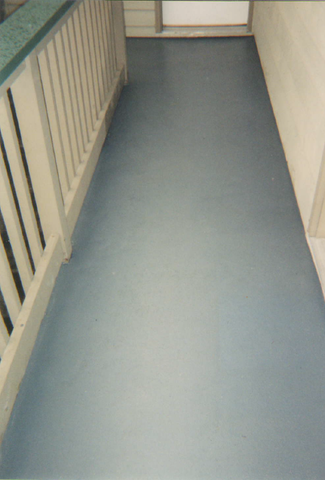Article content
Patio decks and walkways are all pretty similar, but they vary in the amount of wear on the concrete. The first step in restoring a patio deck or walkway is to clean off all of the debris such as mold, mildew, and lose concrete. It is usually best to use a water/Clorox solution to clean and prep your concrete surface. Typically a cup of Clorox in a gallon of water, applied with a garden sprayer will do the job right! You want to create your cleaning solution, and then spray it onto your surface, keeping the surface wet for 20-30 minutes. Then you want to take a 2500 PSI, a 15 degree nozzle, and a pressure washer, and sweep the substrate surface using a vertical / horizontal motion. It is best to hold the nozzle about 4 inches from the surface. Now you will remove the dead debris, loose concrete, and end up leaving puddles on the deck. Next, take a marker and draw a line around the puddles. Then label the puddles, and take pictures of them. Then take a long carpenter level and slide the level over the puddle area and make some notes as to how much polymer concrete is needed to fill in the area. Also with the level, make sure that the deck plate is sloped away from the structural wall and the water will run off the edge of the walkway into a drainage system of some kind. You have to have a minimum of a ¼” per foot slope to ensure the water is going to drain off the walkway away from the building structure.
Once all of the prep is done, apply one coat of Durabak smooth at 15 wet mils thickness. When the first coat is dry, apply a second coat of Durabak 18 non-slip at 15 wet mils and this will complete the applications.
On a 70 degree day, with a relative humidity of 30% the first coat should be dry in 45-60 minutes and then the second coat can be added. Light foot traffic can start about 6 hours after the second coat is dry. Moving things over the surface of the deck should be put off for at least 72 hours after the second coat is done. This will allow the Durabak material to cure out and become very strong. When checking the atmosphere temperature remember to check the substrate temperature also. The atmosphere temperature may be 70 degrees, but the substrate temperature can be cooler or hotter. This can affect the drying time. A good rule of thumb is that for every 10 degrees above or below, an hour can be added onto the drying time. If there is a 15 degree F difference in temperature; the drying time can go out to 2 or 3 hours. I would caution against applying the Durabak or Durabak 18 when the substrate is hotter than 80 degrees. If it is in the middle of summer and the temperatures between noon and 4 pm are high, start your project early in the morning like 5 or 6 am, or wait to apply the Durabak or Durabak 18 after 4 pm in the afternoon. On hot days, do all the prep work during the hot time of the day, and do the coating before the substrate is above 75 degrees or after the heat of the day or sun is moving off the substrate.
The next issue with decks is when the deck slopes into the structure instead of away from the structure. Remember you need a minimum of a ¼” slope per foot. Follow the prep procedure above, and then an over lay of a water based or MMA based polymer concrete can be used to re-slope the deck plate. Once all of the prep is done apply one coat of Durabak smooth at 15 wet mils. When the first coat is dry apply a second coat of Durabak 18 non slip at 15 wet mils.That should complete your deck project.
Usually a deck takes 2 days to complete. The first day is all about the prep work to be done, and the second day the coatings are applied. Some projects can of course take longer, but on average it is safe to assume that your project will take roughly two days from start to finish.








